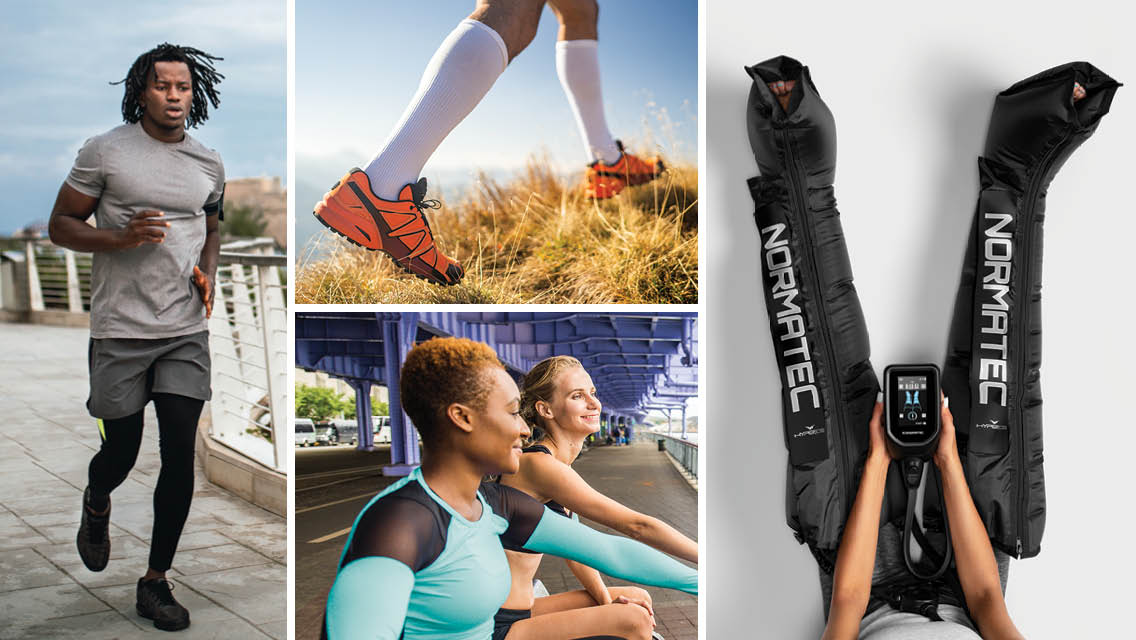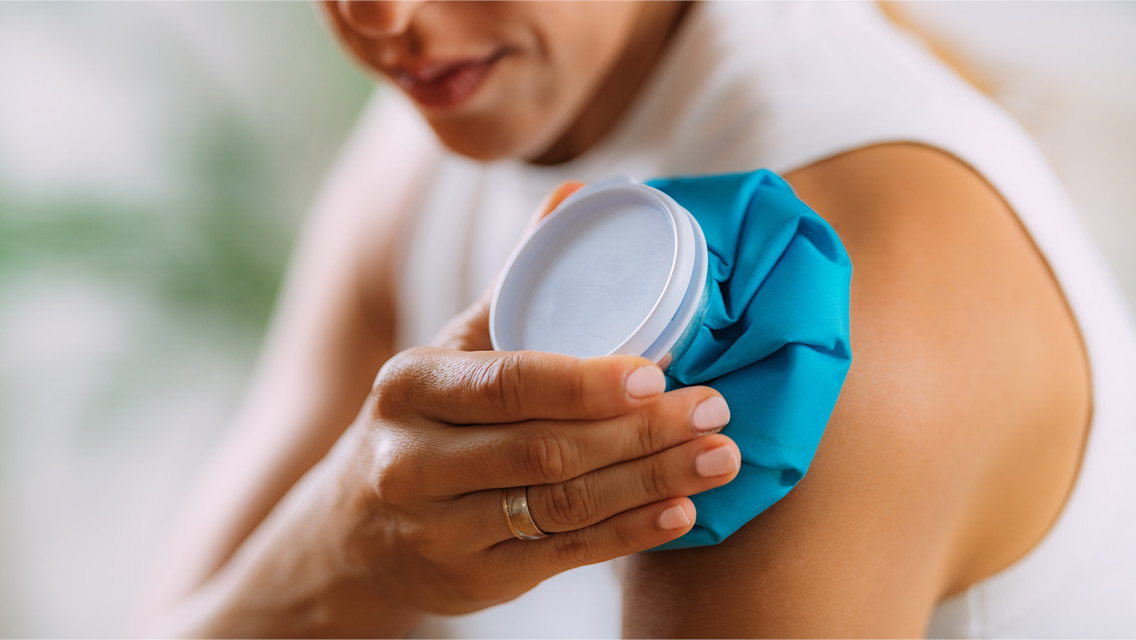Your circulatory system plays a major role in exercise, delivering oxygen, nutrients, and hormones to every cell in your body while also removing waste. Every time you lift weights, run, or practice yoga, circulation affects both your performance and your recovery.
Compressing muscles and veins to improve blood flow can affect how hard muscles work and how quickly they recover. Compression garments, like socks, shorts, and sleeves — as well as pneumatic-compression devices, commonly seen in the form of inflatable devices attached to a pump — are popular ways to manipulate the circulatory system in hopes of boosting performance, speeding recovery, or both.
“Any type of exercise creates localized swelling and inflammation,” explains Life Time master trainer Danny King. “Compression attempts to push fluid out to dissipate this response by getting rid of blood and waste products and bringing new blood in.”
Learn more about how these different compression technologies work.
Compression Garments
Compression wear is designed to provide enough pressure to help reduce blood pooling in the veins and increase blood flow through the arteries to working muscles. There’s a wide range of this type of clothing, including socks, calf and arm sleeves, shorts, shirts, and pants made of tight-fitting technical materials.
Physicians have long prescribed compression garments to reduce swelling and blood clots, and they’re also used by many athletes and exercisers, who swear that the garments aid performance and recovery.
Exercise-focused compression garments typically offer either graduated compression or directional compression, explains Danny Blake, MS, CSCS, director of human performance for the Rocky Mountain Consortium for Sports Research.
Graduated compression refers to a piece of fabric that is tighter distally, or farther from the center of your body (for instance, at your ankles or wrists), and looser closer to the torso (for instance, the hips, shoulders, or abdomen). Directional compression features multiple pieces of fabric with a range of elasticity and improved proprioceptive feedback.
So, do they really work? Research has offered mixed conclusions, with more robust evidence supporting compression for recovery than for performance. Results vary depending on the activity and its intensity.
Compressing muscles and veins to improve blood flow can affect how hard muscles work and how quickly they recover.
One 2017 roundup of 23 peer-reviewed studies found that people who wore compression garments during and after exercise enjoyed recovery benefits, especially 24 hours after resistance workouts. A 2014 analysis of 12 studies also showed that these garments enhanced recovery, moderately reducing the severity of delayed onset muscle soreness (DOMS).
Directional compression has yet to undergo any large-scale research, but a small study involving alpine skiers showed that wearing this type of tights with additional fortification around the knee joints eased the ground-reaction forces the joints experienced. “The researchers found that wearing directional compression reduced forces at the knee, which were redistributed to the hip,” Blake explains.
Clothing is one of the most accessible ways to incorporate compression therapy into your routine — and even a placebo effect can be positive.
“Using compression garments is such an easy thing,” King says. “There are no negative consequences, they’re probably going to work, and they’re not incredibly expensive.”
To boost postexercise recovery, wear them for a minimum of 30 minutes during exercise or within 12 hours after a workout, he suggests. Choose a mild or medium level of compression and make sure the item fits tightly against your skin but not so tightly that it cuts off circulation. If a garment causes numbness, difficulty breathing, or skin irritation, remove it immediately.
Pneumatic-Compression Devices
Popularized for fitness recovery by companies like Normatec, pneumatic-compression devices use inflatable cuffs or boots slipped over legs, feet, or arms. Connected to a pump, a device inflates and squeezes through a series of zones from your feet up to your hips, or from your wrists to your shoulders, massaging your limbs and increasing blood flow.
Whereas compression garments rely on passive compression, pneumatic compression is dynamic because there is an active pumping of blood. “Compared to static-compression garments, dynamic compression allows you to get to a higher level of compression before letting go, which allows muscles to release and relax better,” explains King.
This may contribute to reduced muscle soreness, improved flexibility, and better lymphatic drainage and flow.
Research has produced various results regarding pneumatic compression as a recovery tool. It may dissipate DOMS more effectively after strength training than after long endurance exercise. A 2017 study found that athletes using pneumatic compression had reduced stiffness and recovered more quickly from heavy resistance exercise. Meanwhile, another 2017 study involving cyclists found there to be little benefit in enhancing recovery or subsequent performance.
Using compression garments is such an easy thing. There are no negative consequences, they’re probably going to work, and they’re not incredibly expensive.”
Still, the lack of clinical evidence shouldn’t prevent you from trying these devices. The more likely deterrent for many people is the price tag: Most popular pneumatic systems cost about $1,000 — a hefty investment compared with a pair of compressive tights. (More health clubs, gyms, and physical-therapy offices are investing in pneumatic systems and making them available to members and patients.)
Pneumatic compression is ideal for athletes who need to recover quickly between contests, says Blake. He cautions against using these devices too frequently, though, because they can inhibit the body’s natural adaptations to exercise.
“You want to provide the appropriate adaptive signal to the area and allow it to recover, versus trying to blunt that signal and possibly reduce the positive effects of training,” he explains.
Blake adds that using these devices isn’t the only strategy to ensure adequate recovery: “Doing the small stuff, like staying hydrated, making sure your nutrition is sound, sleeping adequately, and managing stress, will be far more potent in the long run than an upper-echelon recovery tool like this.”
But if it’s an approach you find relaxing, pneumatic compression can be a good self-care tool, says King. “As part of a postworkout cool-down, it gives you a much higher perception of relaxation. If you have access, then treating your body better enables you to continue getting fitter at a faster rate.”
Blood-Flow-Restriction Training
Compression technology uses tight garments, boots, and cuffs to boost blood flow to an area of the body; blood-flow-restriction training (BFR) uses tight cuffs and straps to do the opposite.
Although restricting flow may seem counterintuitive given the benefits of increasing circulation, it does offer a unique advantage: BFR allows someone to exercise with lighter weights at a lower intensity while still achieving the musculoskeletal adaptations of heavy resistance training.
“BFR tricks the body into thinking it’s using heavy resistance even when you’re using a lighter load. Metabolically, the body responds similarly to heavy resistance training,” says strength coach and physical therapist Mike Reinold, DPT.
Typically applied under the guidance of a physical therapist, BFR involves placing a tight cuff or strap around the part of a limb closest to the torso — either your upper thigh or upper arm, depending on the affected area — and then performing relevant exercises.
BFR is especially useful for rehab. Following injury or surgery to areas such as the shoulders, hips, and knees, heavy loads may not be appropriate or tolerable, but the muscles around the joint need to be stimulated to grow. For example, studies have found BFR to be an effective method for rehabilitation after ACL (anterior cruciate ligament) reconstruction surgery.
Reinold stresses that BFR is not generally recommended for the average exerciser. If you believe you are a good candidate for incorporating BFR into your training routine, he advises, consult with a trained professional, such as a physical therapist, before trying this approach on your own.
This article originally appeared as “Get Compressed” in the May 2022 issue of Experience Life.






This Post Has 0 Comments